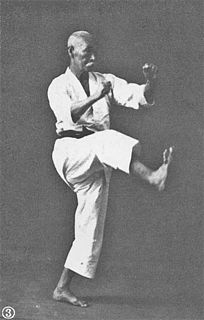
Karate (空手) is a martial art developed in the Ryukyu Kingdom. It developed from the indigenous Ryukyuan martial arts under the influence of Kung Fu, particularly Fujian White Crane. Karate is now predominantly a striking art using punching, kicking, knee strikes, elbow strikes and open-hand techniques such as knife-hands, spear-hands and palm-heel strikes. Historically, and in some modern styles, grappling, throws, joint locks, restraints and vital-point strikes are also taught. A karate practitioner is called a karateka (空手家), and its plural is "karateka" or "karatekas".
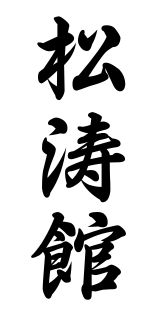
Shōtōkan is a style of karate, developed from various martial arts by Gichin Funakoshi (1868–1957) and his son Gigo (Yoshitaka) Funakoshi (1906–1945). Gichin Funakoshi was born in Okinawa and is widely credited with popularizing "karate do" through a series of public demonstrations, and by promoting the development of university karate clubs, including those at Keio, Waseda, Hitotsubashi (Shodai), Takushoku, Chuo, Gakushuin, and Hosei.
Japan Karate Association is one of the most influential Shotokan karate organizations in the world. It is also one of the oldest karate organizations continuously in operation until the present.
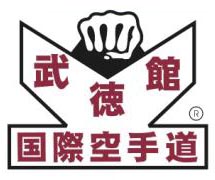
Gosoku-ryū (剛速流) is a style of karate which was founded by Takayuki Kubota. Gosoku stands for hard and fast, which suggests a combination of techniques both from the fast and dynamic Shōtōkan style as well as from the strength-focused Gōjū-ryū style.
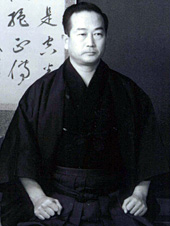
Masatoshi Nakayama was an internationally famous Japanese master of Shotokan karate. He helped establish the Japan Karate Association (JKA) in 1949, and wrote many textbooks on karate, which served to popularize his martial art. For almost 40 years, until his death in 1987, Nakayama worked to spread Shotokan karate around the world. He was the first master in Shotokan history to attain the rank of 9th dan while alive, and was posthumously awarded the rank of 10th dan.
Hirokazu Kanazawa was a Japanese teacher of Shotokan karate. He was the Chief instructor and President of the Shotokan Karate-Do International Federation, an organisation he founded after he left the Japan Karate Association (JKA). Kanazawa was ranked 10th dan in karate.

Dave Hazard is a British 7th Dan Karateka and instructor of Shotokan karate and was one of the few students present at the very beginning of British Karate. He is a former KUGB national champion and British team member. Like many of the early karateka he first trained in judo before starting karate in 1969 at the Blackfriers club in London, where he trained under Keinosuke Enoeda, Hirokazu Kanazawa, Kato and Takahashi.

Teruyuki Okazaki, was a tenth degree black belt in Shotokan Karate, as well as the founder and chief instructor of the International Shotokan Karate Federation (ISKF). Along with Gichin Funakoshi and Masatoshi Nakayama, Okazaki helped found the Japan Karate Association's instructor training program.

Takayuki Mikami is a Japanese master of Shotokan karate based in the United States of America. He holds the rank of 9th dan black belt in the art, awarded under the Japan Karate Association. In 1958, Mikami tied for first place in the All Japan Karate Championships. The following year, he became the All Japan champion in kumite (sparring) as well as kata (patterns). In 1961, Mikami won first place in kata again. He was also the first person to graduate from the Japan Karate Association's (JKA) instructor training program instituted by Gichin Funakoshi and Masatoshi Nakayama.

The Japan Karate Federation (JKF), a.k.a. Japan Karatedo Federation, is a national governing body of sport karate in Japan. The JKF is officially affiliated with the Japan Olympic Association (JOC), World Karate Federation (WKF), Japan Sports Association (JSA) and Japanese Budō Association (JBA). The styles recognized by the JKF are Wadō-ryū, Shotokan, Shito-ryu and Goju-ryu. The headquarters is located in Tokyo, Japan.

Yutaka Yaguchi is the Chief Instructor and Chairman of the International Shotokan Karate Federation (ISKF) Mountain States Region. He was born in Hiroshima, Japan, in 1932 and began karate training in 1952. He later tested under masters Gichin Funakoshi for his 1st dan black belt and Masatoshi Nakayama for his 2nd through 8th dan black belts. As one of the first graduates of the Japan Karate Association (JKA) Instructors' Training Program in 1959, he has played an important role in the growth of JKA karate and the internationalization of Shotokan karate. Yaguchi first arrived in the United States on June 5, 1965, and continues to reside in the US to the present day. In 1974, Yaguchi founded the ISKF of Colorado, the regional headquarters for the Mountain States Region.

Keinosuke Enoeda was a Japanese master of Shotokan karate. He was a former Chief Instructor of the Karate Union of Great Britain. Enoeda was ranked 8th dan in Shotokan karate, and was widely renowned as a formidable karateka. Following his death, Enoeda was posthumously awarded the rank of 9th dan.

Arturo Worrell is a Panamanian Shotokan Karate practitioner, founder and Chief Officer of the Panamanian Association of Shotokan Karate, a JKA affiliated organization. His work of teaching shotokan karate has been instrumental in spreading Shotokan style both in Panama and Costa Rica.
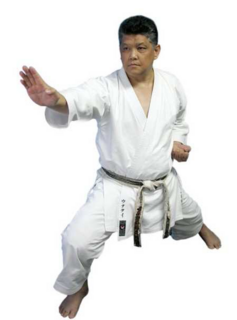
Frank Woon-A-Tai, a ninth degree black belt in Shotokan Karate, is the chief instructor of the International Karate Daigaku, President of the Caribbean Karate College, Chief instructor and Chairman of the Guyana Karate College, and Chairman of IKD Canada and IKD Guyana.

Taiji Kase was a Japanese master of Shotokan karate who was one of the earliest masters responsible for introducing this martial art into Europe. He taught his style of karate, Shotokan Ryu Kase Ha, in France from the late 1960s to the mid-1980s. In his later years, he travelled across the world teaching karate, but Paris remained his home. Kase held the rank of 9th dan in karate.

Hideo Ochi is a Japanese master of karate. He is ranked 9th Dan, and is a former Japan Karate Association (JKA) World Champion in kumite (sparring) and kata (patterns). He was also coach of the German national team and Chief Instructor for JKA Europe. In 1997, he received the Order of Merit of the Federal Republic of Germany.

Shigeru Takashina was the founder and Chief Instructor of the South Atlantic Karate Association, an organization of the Japan Karate Association (JKA). In 1966 he graduated from Ryukoku University in Kyoto and entered the Instructor School of the Japan Karate Association, graduating in 1968. Takashina was the Captain of the Japan team in the 1st World Karate Championships held in Tokyo in 1970 and scored a perfect win. He moved to the United States in 1972.
Japan Shotokan Karate Association (JSKA) is one of the fastest growing Shotokan Karate associations in the world, founded by Keigo Abe in 1999. Abe was a former instructor graduate of the Japan Karate Association and trained and taught at the JKA Headquarters for nearly 35 years. He held a number of senior positions within the JKA and latterly the Matsuno section of the JKA. He had been a senior student of Nakayama and as such the teachings of Nakayama remain an integral part of the evolution of the Shotokan style within the JSKA. Abe Sensei passed away on the 20th of December 2019.
Stan Schmidt was a South African master of Shotokan karate. Along with others, such as Norman Robinson, he was an early practitioner of Shotokan karate in South Africa and his establishment of the South African branch of the Japan Karate Association (JKA) in 1965 after training in Japan, along with his subsequent promotion of the art in South Africa, earned him the appellation of 'The Father of South African Karate'. In 1963, he was one of the first westerners to be invited into the JKA's famous Instructor Class in the Tokyo Honbu dojo and he was later one of four non-Japanese karateka to sit on the JKA's international Shihankai. He was also the first non-Japanese karateka to attain 7th dan from the JKA and also the first to attain 8th dan. Today, he is the highest ranking non-Japanese karate master of that organization. He is also known for his acting roles in several martial arts films of the 1970s and 1980s.














